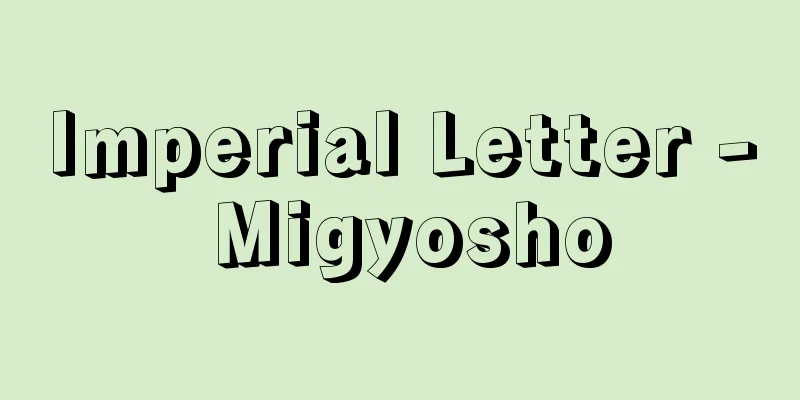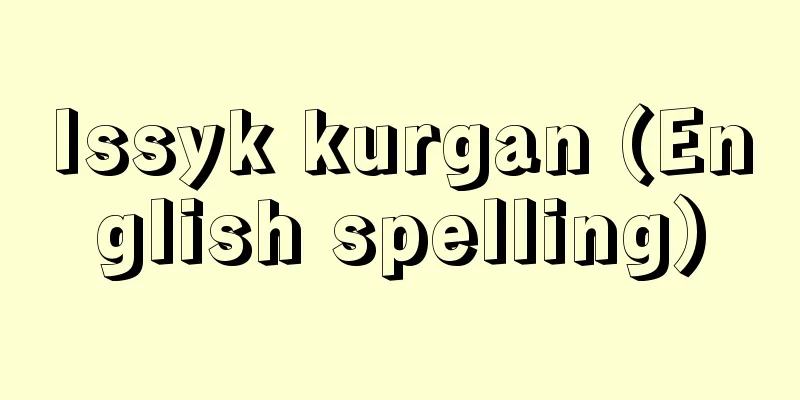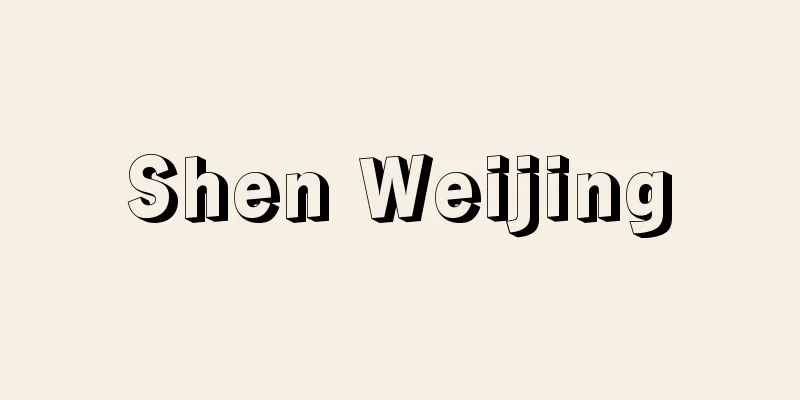Imperial Letter - Migyosho

〘 noun 〙 ("mi" is a prefix) [一] A style of ancient document. Since the Heian period, among the hosho-style documents, this is a type issued at the request of a nobleman of the third rank or higher. It can also refer to hosho issued at the request of a wide range of nobles, including retired emperors. ① A hosho issued by a nobleman. In particular, a hosho issued at the request of a regent or other such official. Such as a letter from the regent's family. ※Shomonki (around 940): "An official letter to the effect that the facts should be examined, <abbreviated> a letter sent to me by the Empress Shoshin Taji no Masato no Sukezane." ② In the Kamakura period, a hosho issued at the request of the shogun. Early versions were characterized by the words "In accordance with the wishes of the Kamakura Shogun " in the main document, but during the time of the third shogun, Minamoto no Sanetomo, the style began in which the signatures of regent Hojo Yasutoki and cosigner Hojo Tokifusa were attached to the signatures, and later the style changed to one in which two people were attached to the signatures. This is called Kanto Gokyosho, and usually has the phrase " by order " in the text. Similar documents were also issued by the Rokuhara Tandai and Chinzei Tandai, and are called Rokuhara Gokyosho and Chinzei Gokyosho. ※Taike in Takano (before 13th century) 12 "The Lord has kindly given permission. This is the Kamakura Shogun's Gokyosho ." ③ A letter issued by the head priest of a large temple. If the issuer has the title of junsanko , it is often called a ryoji . [2] A letter with the sleeve seal of the Shogun of the Kamakura Shogunate. ※Azuma Kagami - May 3, 1213 (Kenryaku 3) "The said Gokyosho (with the Shogun's seal ) was sent as an envoy to Yamata Sotaka, a resident of Aki Province." [3] A letter with the Gokyosho 's seal. During the Nanboku-cho and Muromachi periods, the Shogun wrote his signature and issued the document directly. The Shogun wrote his signature on the sleeve of the document (the blank space on the right side) or under the date, and the document was not in the hosho format. *Toraakirahon Kyogen: Aso (late Muromachi period - early modern period) "I received a letter of relief and was bestowed new land."Mi-gyouso ‥geuso [Edict]Source: The Selected Edition of the Japanese Language Dictionary About the Selected Edition of the Japanese Language Dictionary Information |
〘名〙 (「み」は接頭語)[一] 古文書の様式の一つ。平安時代以来、奉書形式の文書のうち、三位以上の公卿の意を承って出すもの。また、上皇などをはじめ、ひろく貴人の意を承る奉書をいうこともある。① 公卿の奉書。特に、関白などの意を承って出される奉書。摂関家御教書など。※将門記(940頃か)「実否を挙ぐべきの由の御教書、〈略〉中宮少進多治真人助真が所へ寄せて下さるるの状」② 鎌倉時代、将軍の意を承って出される奉書。初期のものは本文書留に「依二鎌倉殿仰一」の文言があるのが特徴であったが、三代将軍源実朝の時、執権北条泰時・連署北条時房の二名が署を連ねる様式が始まり、のち、奉者が二名の様式となる。これを関東御教書といい、普通本文中に「依レ仰」の文言がある。また、同様の文書を六波羅探題・鎮西探題も出しており、六波羅御教書・鎮西御教書という。※高野本平家(13C前)一二「若公ゆるさせ、給ひて候。鎌倉殿の御教書(ミケウショ)是に候とて」③ 大寺院の座主(ざす)などの発する奉書。発する者が准三后の称号を受けていれば、多く令旨(りょうじ)と呼ばれる。[二] 鎌倉幕府将軍の袖判の下文のこと。※吾妻鏡‐建暦三年(1213)五月三日「彼御教書〈被レ載二将軍御判一〉者、以二安芸国住人山太宗高一為二御使一被レ遣」[三] 御判(ごはん)の御教書のこと。南北朝・室町時代、将軍が花押(かおう)を書いて、直接発給する形をとった文書。文書の袖(右側の空白部)、または年月日の下に将軍が花押をすえた文書で、奉書形式をとっていない。※虎明本狂言・麻生(室町末‐近世初)「安堵の御教書を下され、新地を拝領いたし」
み‐ぎょうそ ‥ゲウソ【御教書】出典 精選版 日本国語大辞典精選版 日本国語大辞典について 情報 |
Recommend
dāgaba (English spelling) dagaba
…The most distinctive feature of Sri Lankan templ...
Manticore
…A fictional monster. In Greek, it is called Mant...
Kim Bang-kyung - Kim Bang-kyung
Year of death: Chungryeong 26.8.16 (1300.9.29) Yea...
Irish Literary Theatre
…It is confirmed by documents that religious play...
Aconite - Ugly
The title of a Kyogen piece. Tarokaja Kyogen. The ...
Wa tribe - Wazok (English spelling)
They live from the area east of the Salween River...
Edition of the Nouvelle Ruby Française - Edition of the Nouvelle Ruby Française
…Founder of a major French publishing house. In 1...
Shomyoji Temple
A Shingon Buddhist temple in Kanazawa-cho, Kanazaw...
Ichinoseki - Ichinoseki
…The Ichimonji weir is probably the most common t...
Tenei [village] - Tenei
A village in Iwase County in the central-southern ...
baker's itch
…Acarid mites are not only pests that infest food...
Positivität (English spelling)
...From this, positum came to mean "an irrat...
Shura Sugae - Akera Kanko
Year of death: 12/12/17 (1799/1/17) Year of birth:...
Maniu, I. (English spelling) ManiuI
...The lineage of fantasy fiction developed throu...
Cantilever
〘Noun〙 (cantilever) ① A part of the cartridge that...









